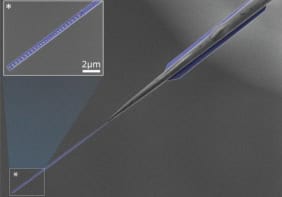
Surfaces inspired by cicada wings and mosquito eyes have antifogging properties. A team of scientists from France and the US has created surfaces that mimic these natural systems, in an attempt to replicate their anti-fogging mechanisms.
When water comes into contact with a surface, its behaviour can vary from beading into tiny droplets to spreading evenly over the surface. For water-loving, hydrophilic materials, the droplet will spread out and maximize contact with the surface. In contrast, for water-repelling, hydrophobic materials, the water forms beads. This behaviour is due to the angle between the droplet’s edge and the surface directly underneath – known as the contact angle. When the contact angle is more than 90°, the surface is considered hydrophobic. If it is higher than 160°, the material is superhydrophobic and strongly repels water, even causing it to bounce off. While superhydrophobicity is dependent on surface chemistry, the texture of the surface also plays a vital role.
“Many textured materials can repel water, with millimetre-size water drops bouncing off their surfaces,” explains team member Charles Black of Brookhaven National Laboratory in the US. In these cases, the water droplets are too big to penetrate the surface features and remain on top of the texture, floating on a cushion of air. Therefore, the surface remains dry. “But many of these surfaces fail when exposed to foggy or humid conditions,” Black continues. Under these conditions, moisture condenses as microdroplets that are comparable in size to the surface features. The fine droplets nucleate and grow among the features. This water remains stuck as dew accumulates, and any larger droplets on the surface also become attached. The result is a wet material.
Survival features
While man-made superhydrophobic materials often suffer this limitation, a solution can be found in nature – specifically, on the surfaces of insects. Bugs have tiny nanoscale features on their surfaces. These give the insects properties that are essential for survival. For example, moth eyes have low light reflectance, springtail carapaces repel oil and palmtree bugs are ultra-adhesive. Meanwhile, anti-reflective mosquito eyes and cicada wings display anti-fogging properties and self-cleaning capability.
The team from École Polytechnique, ESPCI Paris Tech and the Thales Group in France alongside Brookhaven scientists used cicada wings as inspiration. These have a textured structure comprising tiny nanocones. Water droplets can spontaneously jump off these surfaces because of the efficient conversion of surface energy to kinetic energy when two droplets combine. Timothée Mouterde and team investigated the underlying anti-fogging mechanisms of man-made structures mimicking the cicada wings and the effect of feature size and shape.
To make the textured samples, the researchers used a method initially developed at Brookhaven. The technique uses block copolymers (chains of two linked, distinct molecules) that can self-assemble into ordered patterns with nanoscale dimensions. The researchers covered etched silicon with these hydrophobic molecules to create the desired textured surface.
Drip feeding
Foggy atmospheres were created by drip feeding hot water onto the cold surface. This causes some of the water droplet to evaporate and then condense as microdroplets in subjacent textures. By tilting the substrate, the scientists measured the mass of the droplet when it became detached at the bottom of the slope. The mass reveals how much of the condensed microdroplets adhered to the larger droplet – a measure of the water repellency. Using an optical microscope, the team was also able to watch the droplet formation.
The study, presented in Nature Materials, reports two key results – smaller features mean greater anti-fogging ability and cones are better than cylinders. “We show that water condensing on cold nanocones gets expelled with an unprecedented efficiency,” explains David Quéré of École Polytechnique and ESPCI. The scientists observed that all textures are initially covered in many microdroplets, but over time the cylinders become covered in water. Meanwhile the cones “dry” themselves in a manner similar to the cicada wings. As the droplets are so lightly adhered to the surface, when two join together, they gain enough energy to jump off the surface. “Droplets as small as 1.5 μm were repelled from the surface,” continues Quéré, “while it is said generally in the literature that this should not occur for drops smaller than 10 μm.”
Hot water
The next stage for the research is to look at the velocity droplets depart from the surface. “It is a very interesting question at the crossroads of fluid mechanics and interface physics,” Quéré says. “We are also studying the impact of hot water on our textures to see whether water repellency is maintained when water is hot.”
Antifogging materials could be useful for vehicle windshields and mirrors, corrosion-prone materials and other fog-prone surfaces. Whether these man-made structures can achieve the performance of natural materials remains to be seen, however, as the mosquito eyes and cicada wings are too small to perform similar experiments.



